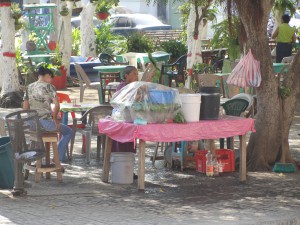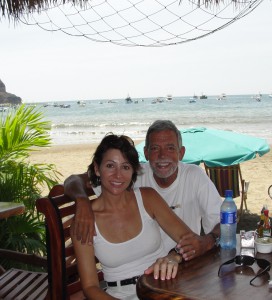I really don’t know where to begin. So I’ll start at the beginning, like a novice storyteller.
On Tuesday, March 9, my husband and I traveled from Costa Rica to Nicaragua for a three day journey. We’d heard wonderful things and were ready for an adventure. Shock and awe. Truly, shock and awe. We began with two days in Granada, the oldest existing city in Central America. But wait… first, I need to tell you…
Old McDonald has lost control. Unfortunately, I did not get pictures of one of the most amazing aspects of the third-world country because the first and most shocking vision of the country was from the taxi ride in, zipping past lean-to shanties on the side of the road. The shacks (which I was told do have electricity and water) were homes for the farmers. We knew they were farmers because their animals were everywhere. Cows, horses, oxen, goats, pigs, chickens, roosters, you name it, were hanging out on the sides of the road, grazing, sleeping, watching the cars go by. Literally just standing there. Sometimes, they had the goats tied up on leashes, but mostly they just hung out, waiting I suppose to be put to work or eaten for dinner.
When we got to the town, established in the late 1500s, our wonderful colonial hotel was located right across from the piazza, the town square. (Check out www.vianica.com. We stayed in Granada at the Hotel Plaza Colon for $100/night, including air conditioning and sometimes hot water.) We sat for hours on our hotel balcony watching the families sell their wares, the exact same way we imagine they’ve done for years, probably decades, passing the responsibilities down through the generations. The women create and sell the food or crafts; the men assemble the tables, chairs, and paraphernalia each morning; the children disassemble the same each night, only for the men to set everything back up the next day and the process repeats itself day after day. They used horse-drawn home-made carts to haul everything back and forth each night. This square was mainly geared towards tourists, but the old men who sat all day to shine shoes attracted the locals who must have worked in shops and restaurants. They actually wore shoes… not everyone did.
In the central square, a cafe and an old woman selling bojo, which she boils under the plastic for 5 hours each day.
A few blocks away was the local market. Here… better than ten thousand words:
We took a tour of the city, via horse drawn carriage, with a tour guide (Fabio!). The city was very clean and safe. We never felt the least bit nervous or threatened, although he did tell us to stay around the main square after dark. The food was delicious, and the prices were extremely low. Their money is Córdobas, about 20 to 1 vs. the dollar. Beer and water are the same price: $1/bottle. Not kidding. Lunch cost about $3 each, dinner maybe cost $8 each. We tried street food (bojo) (pronounced “bow”) and Indio Viejo and gallo pinto (red beans & rice) with chicken. Our favorite new food is fried plantains (yes, I’m eating fried food now), in fact, I make plantains with every dinner we eat at home.
Okay, I could go on and on and on. We saw an active volcano ~ actually looked right down into the mouth. It’s like the Grand Canyon filled with steam. The locals call it “The mouth of hell,” though they’ve fortunately stopped preforming living sacrifices to appease the gods.
On the way back south towards Costa Rica, we stopped in a Pacific coast town called San Juan del Sur. It’s very “tranquil,” as they told us about ten times. For lunch, at El Tímon on the beach (below), we had lobster ceviche with a hint of orange (probably the local fruit that is a mix between a lime and a tangerine. I’m not sure what it’s called). Absolutely, mouth-wateringly, indescribably delicious. We stayed at El Victoriano. Look it up on that same web site. It, too, was wonderful.
All right, I’ve run out of adjectives and probably space. Hasta luego!







